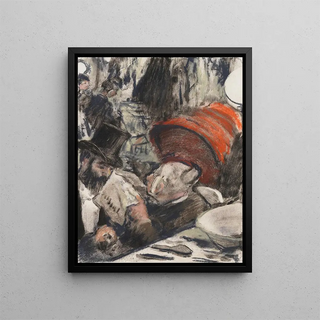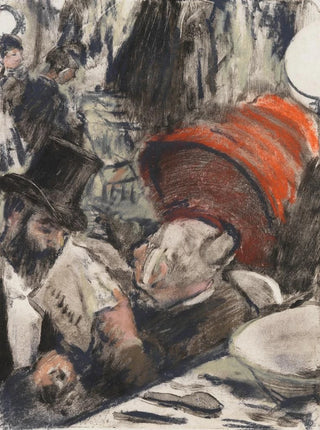Painting Ludovic Halévy finds Madame Cardinal in the boxes - Edgar Degas | Art print


View from behind

Frame (optional)
The artwork "Ludovic Halévy finds Madame Cardinal in the boxes" by Edgar Degas is an iconic piece that captures the very essence of Parisian life at the end of the 19th century. In this intimate scene, Degas immerses us in the hushed world of the Opera boxes, revealing subtle interactions between the characters and the vibrant atmosphere surrounding them. The subdued lighting, refined costumes, and delicate expressions of the protagonists testify to a fleeting moment, frozen in time by the artist's skillful brushwork. Through this piece, Degas does not merely depict a simple encounter; he evokes a story, an emotion, an atmosphere that one can almost touch.
Style and uniqueness of the work
Degas's style is distinguished by its innovative approach and meticulous attention to detail. In "Ludovic Halévy finds Madame Cardinal in the boxes," the artist skillfully plays with angles and composition, creating a dynamic that draws the viewer's eye. The characters, although frozen in seemingly natural postures, are animated by palpable tension. The colors, meanwhile, oscillate between warm tones and darker shades, enhancing the scene's mystery. Degas excels in depicting movement and emotion, making each gesture meaningful. The pastel technique, so favored by the artist, gives the artwork a unique, almost tactile texture that invites visual exploration. Thus, this piece is not limited to a simple representation but transforms into an immersive experience where the viewer is invited to reflect on human relationships and social contexts.
The artist and his influence
Edgar Degas, a major figure of the Impressionist movement, left his mark on his era with his unique vision of reality. Although he often distanced himself from luminous landscapes and outdoor scenes that characterize his contemporaries, he captured the beauty of ordinary moments, slices of daily life, with rare emotional depth. His fascination with ballet, theater, and Parisian life shaped a large part of

Matte finish

View from behind

Frame (optional)
The artwork "Ludovic Halévy finds Madame Cardinal in the boxes" by Edgar Degas is an iconic piece that captures the very essence of Parisian life at the end of the 19th century. In this intimate scene, Degas immerses us in the hushed world of the Opera boxes, revealing subtle interactions between the characters and the vibrant atmosphere surrounding them. The subdued lighting, refined costumes, and delicate expressions of the protagonists testify to a fleeting moment, frozen in time by the artist's skillful brushwork. Through this piece, Degas does not merely depict a simple encounter; he evokes a story, an emotion, an atmosphere that one can almost touch.
Style and uniqueness of the work
Degas's style is distinguished by its innovative approach and meticulous attention to detail. In "Ludovic Halévy finds Madame Cardinal in the boxes," the artist skillfully plays with angles and composition, creating a dynamic that draws the viewer's eye. The characters, although frozen in seemingly natural postures, are animated by palpable tension. The colors, meanwhile, oscillate between warm tones and darker shades, enhancing the scene's mystery. Degas excels in depicting movement and emotion, making each gesture meaningful. The pastel technique, so favored by the artist, gives the artwork a unique, almost tactile texture that invites visual exploration. Thus, this piece is not limited to a simple representation but transforms into an immersive experience where the viewer is invited to reflect on human relationships and social contexts.
The artist and his influence
Edgar Degas, a major figure of the Impressionist movement, left his mark on his era with his unique vision of reality. Although he often distanced himself from luminous landscapes and outdoor scenes that characterize his contemporaries, he captured the beauty of ordinary moments, slices of daily life, with rare emotional depth. His fascination with ballet, theater, and Parisian life shaped a large part of
12,34 €






